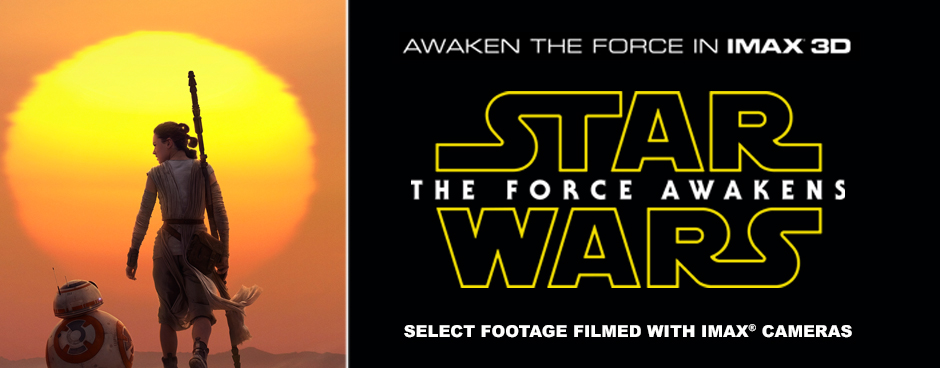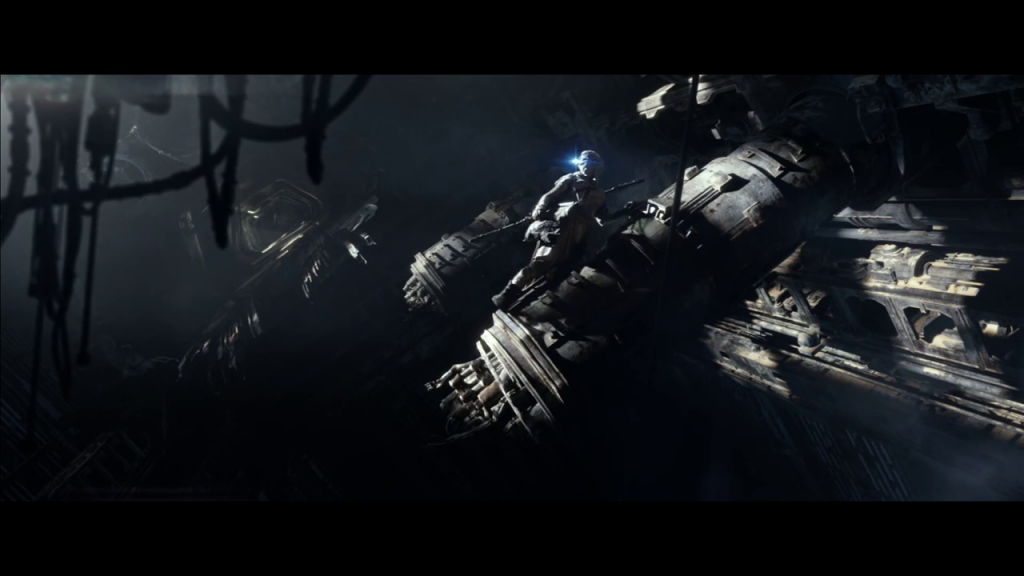Star Wars: The Force Awakens Stereo Conversion is Awe Inspiring and You Should See It.

In a darkened IMAX3D theater I saw Star Wars: the Force Awakens for the second time. My first viewing was at the Motion Picture Academy screening with JJ Abrams, Kathleen Kennedy, Roger Guyett, and many others. I was already pretty impressed with the film, and I had a few complaints, but they were minor. As I watched it again, on a gigantic IMAX screen, at twice the brightness of a standard 3D projector, drowned in chest thumping sound, I was hooked. I took a moment to look around, as a full-screen Star Destroyer poked out into the theater. Most of the time people just look at the screen, but as I looked away, I noted that the spacecraft floated above all the audience members before me. My nine-year old inner child leapt with excitement, and the magic of the movies had me.

What surprised me most were the quiet scenes seen for months in online trailers. The interior of the fallen Star Destroyer was already fairly impressive, but now it truly had a sense of scale that you only get from a location by being there. That is what the stereo version of the film provides, that its 2D counterpart misses: that sense of being there. Unlike a well done VR experience, in which by all account you ARE there, this fits in the same experience as memory of that trip to the Grand Canyon, or the Grand Tetons, or your first walk under the Eiffel Tower. You can’t really go inside, but stand back in awe at how large it is, and focus on the people in it. Best of all it is never distracting, and feels natural. The rules of perspective seem to be intact, even when they are artfully crafting the depth for greater impact. The reflections are deep, and the sand dunes treacherously tall. It is extremely well done. There are a few flaws that only the trained eye will grasp, but they are minor and I would rather not sully your experience when seeing it by telling too much.
The State of 3D Conversion 2015
Although 3D conversion has improved over the years, by watching the trailers for several other upcoming movies, you can see a wide variety of quality. I feel that there is still an arm of Hollywood production that does not understand the medium, and would rather slap the 3D title on a film that did not give enough time for the conversion team to complete their jobs, and grab a bunch of money from higher price tickets. Lucky I am one of the only people who really know what I am talking about, and can comment on it, as I did it first.
I created much of the stereo3D conversion methodology out of existing VFX techniques for IMAX films by 2002. I left BOSS films in 1996, and pursued the medium, as I had a fascination with stereo photography since I was 9 (and Star Wars too…hmm). After spending 10 years of my career in the stereo 4K VFX industry I figured it was time to move out of the science centers, and get back into mainstream VFX. Few people anticipated the explosive growth of 3D content following James Cameron’s Avatar. On its heels came an avalanche of shoddy product (Looking at you, Clash of the Titans) barely based on that methodology (which some have patented after the fact — we will see how that plays out). I quickly got back in to the field, and figured we had five years to save it. It was s struggle at times to do so.
Happily, the quality of stereo3D films jumped dramatically in approximately three years, and now conversion is the primary way 3D films are produced. In conjunction with photographed, and rendered stereo content, there is a wide wonderful world of sculpted movies jumping across our screens, but many are still missing some of the lessons the Star Wars team is getting right, and it is almost always evidenced in the trailer.
I saw the Ant-Man trailer in 3D theaters around the same time I was seeing the 3D trailers for Star Wars the Force Awakens, and although Ant-Man was a good 3D film because of its rendered 3D stereo VFX, its conversion sections suffered from pushing too much depth in shots photographed with longer “zoom” lenses. That choice pulled me out of the film. Alternately the Star Wars 3D trailers promised exactly what I have been writing about above. The trailer sells the movie. It sells the quality VFX. It also sells the 3D experience you expect (which is one of the big failures of the recent Conan film, which had a fantastic 3D trailer, and poor 3D conversion for everything else).
As an example compare these two Star Wars and Ant-Man reviews to illustrate the popular reception.
Several 3D trailers shipped with Star Wars. I’ll share my reaction to them as an analysis of how much attention they demonstrate is being paid to this part of the film experience. This is not intended to denigrate the film, or its final 3D version, but to inform what the current state of the industry is, and what the trailers are selling as far as a 3D experience goes.
Analysis of 3D trailers before Star Wars 7 IMAX3D screening 12/24/15
- Warcraft 3D trailer. From just watching the trailer in front of Star Wars, it is obvious that someone wants MAXIMUM 3D out of this film. They are not analyzing the way the depth budget is moving across the edit, or what the lens and perspective dictate to the eye, but rather keep nearly the same 3D volume for every single shot. Very distracting when the depth is not content aware. My eyes are watching all the backgrounds, and not focusing on the characters in the foreground, which is where the rules of perspective and depth tell me I should be looking. The thing with the greatest depth tells you if something is close to your head, and by default your mind pays attention to it. Hopefully this is just the first pass, or the particular chosen shots just seem to all be the same, and were not balanced for a trailer.
- Batman vs. Superman 3D trailer. This one is a mixed bag. Since so many different lenses are used in this franchise, there seems to be a smattering of spot-on, and distracting 3D converted content. Most Directors of Photography favor longer lenses to reduce the distortion of an actors face a wide lens produces, but then someone pushes the overall 3D volume in post— which is apparent here — rather than giving more of that depth budget to the expensive actors they paid for, and want us to look at. Overall the feeling is good, and the film may warrant a 3D viewing, as this is only a trailer.
- Independence Day: resurgence 3D trailer. What a fantastic 3D trailer! The character volumes are intact, the depth well used, and the sense of scale within the scenes rivals that of Star Wars. This is a 3D must-see.
- Captain America Civil War 3D trailer. Following in the footsteps of most of the Marvel 3D content (except the poor First Avengerconversion), this film seems to have a good sense of 3D depth, sculpture and balance, and is on my must-see 3D list.
- Jungle Book 3D trailer. For a film supposedly lensed in 3D, this trailer certainly looks like a stereo conversion. Perhaps this is done to 2D imagery for the sake of time, but all indications are that this trailer is converted. Either way, If you want a pop-up book, with little consistent character sculpture and flat backgrounds that seem too deep for the scene, then this is what’s advertised for you. This is only a trailer. This film may be far from finished, but slapping this onto the front of your tent pole production without even fixing seemingly egregious paint errors is a sure way to hurt your sales. Luckily, the 3D conversion of this trailer will not be final. Time will tell, and we should keep an eye on later trailers vs. the final film. (ed note: Having just seen the final film — the trailer completely under-sells the majesty of the 3D. See it in IMAX or 3D Dolby Laser if possible]
Looking at these examples, although out of the water, it seems stereo3D converting live action films is not totally out of the woods yet. I look forward to every film on that trailer list. In my mind my ticket is already purchased, but unless you can approach the quality of 3D content Star Wars 7 just gave audiences worldwide, you may be literally selling yourself short. Even if trailers are examples of incomplete conversion, please learn the lesson from the controversy the first Iron Man created showing incomplete VFX too soon — and spend time on the trailers to sell the 3D. I believe Orson Welles used to push “Never sell a wine before its time.” So true that is for VFX and Stereo conversion. (Interesting to note that the first Iron Man, and Jungle Book are both Jon Favreau films).
Productions should find the money. Find the way. Find the time to make your 3D experience actually that: an experience. Give us scale. Give us characters we want to look at even closer. Give us a sense of being there. Give us what you see in Gravity, and Star Wars the Force Awakens. Make it a stereo3D experience to write about!
AG
All images ©2015 LFL
